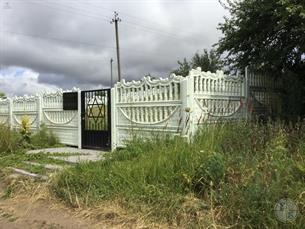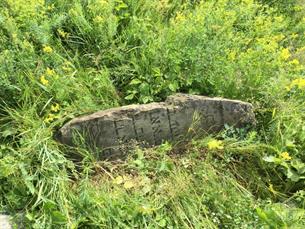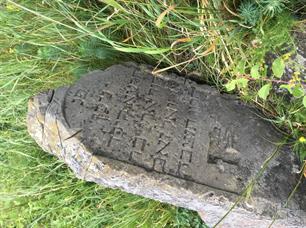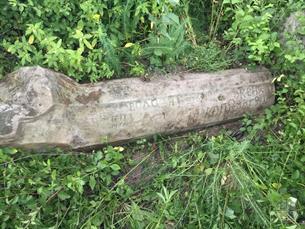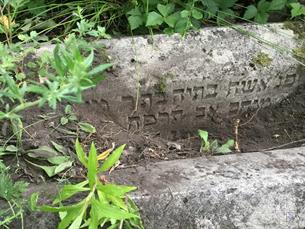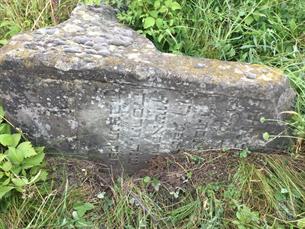Hoshcha
Rivne district, Rivne region
Sources:
- Russian Jewish encyclopedia. Translated from Russian by Eugene Snaider;
- Jewish encyclopedia of Brockhaus & Efron;
- Virtual Shtetl. Hoszcza;
- The All South-Western Territory: reference and address book of the Kyiv, Podolsk and Volyn provinces. Printing house L.M. Fish and P.E. Wolfson, 1913;
- I.Altman (ed.), Holokost na tieritorii SSSR, Moscow 2009
Photo:
- European Jewish Cemeteries Initiative. Hoshcha Jewish Cemetery
- Sakateka, Wikipedia. Hoshcha palace
- Muzeum Historii Zydow Polskich POLIN. Ha-Shomer Ha-Tsair member's ID in Hoshcha. Published by Virtual Shtetl
- Russian Jewish encyclopedia. Translated from Russian by Eugene Snaider;
- Jewish encyclopedia of Brockhaus & Efron;
- Virtual Shtetl. Hoszcza;
- The All South-Western Territory: reference and address book of the Kyiv, Podolsk and Volyn provinces. Printing house L.M. Fish and P.E. Wolfson, 1913;
- I.Altman (ed.), Holokost na tieritorii SSSR, Moscow 2009
Photo:
- European Jewish Cemeteries Initiative. Hoshcha Jewish Cemetery
- Sakateka, Wikipedia. Hoshcha palace
- Muzeum Historii Zydow Polskich POLIN. Ha-Shomer Ha-Tsair member's ID in Hoshcha. Published by Virtual Shtetl
Urban-type village (since 1959), until 2020 - the district center in the Rivne region. Known since the 14th century. Since 1793 - as part of the Russian Empire. In the 19th - early 20th centuries - the township of Ostroh district of the Volyn province. In 1919–39 - in the Volyn Voivodeship as part of Poland, in 1939–91 - as part of the Ukrainian SSR.
In 1847, 338 Jews lived in Hoshcha,
in 1886 - 678,
in 1897 - 884 (42.3%),
in 1921 - 881 Jews (36.3%),
in 1941 - approx. 1000 Jews.
Jews lived in Hoshcha since the 16th century.
In the 19th century the synagogue acted.
In 1889-1903, J. Lamden was a rabbi.
In 1913, Jews owned only wood warehouse, both honey factories, both mills, all 29 shops (including 19 grocery).
In the 1920-30s in Hoshcha acted departments of various Jewish parties and organizations.
In 1847, 338 Jews lived in Hoshcha,
in 1886 - 678,
in 1897 - 884 (42.3%),
in 1921 - 881 Jews (36.3%),
in 1941 - approx. 1000 Jews.
Jews lived in Hoshcha since the 16th century.
In the 19th century the synagogue acted.
In 1889-1903, J. Lamden was a rabbi.
In 1913, Jews owned only wood warehouse, both honey factories, both mills, all 29 shops (including 19 grocery).
In the 1920-30s in Hoshcha acted departments of various Jewish parties and organizations.
 |
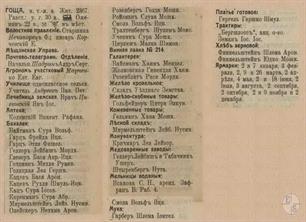 |
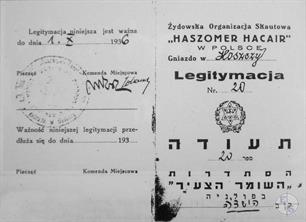 |
| The palace of Vasilevsky in Hoshcha, 2020 | Hoshcha in the 1913 reference book | Ha-Shomer Ha-Tsair member's ID in Hoshcha, 1936 |
On July 4, 1941, German troops entered Hoshcha. In July and August 1941, the war commandant managed the town, and from September 1941 - German civil administration. Hoshcha was included in the police station. A general commissioner became an official named Beer. In Hoshcha there was a post of the German gendarmerie, as well as the headquarters of the Ukrainian police.
In the summer or autumn of 1941, Judenrat was designated in Hoshcha, Jews were ordered to wear distinguishing signs in the form of a star of David (later in the form of a yellow circle), they were sent to heavy free works, they were forbidden to go beyond the boundaries of the town, they fell victim to systematic plunders and beat with Ukrainian police.
At the end of July 1941, the first anti-Jewish action was carried out in the village, during which 10 Jews were caught and shot. The subdivision of the 10th Motorized Infantry Regiment of the SS, whose staff on July 27-28, 1941 was in Hoshcha, most likely shot. On May 20, 1942, a second action was carried out, during which SD in cooperation with the German gendarmerie and the Ukrainian police shot 670 Jews. The action was also attended by a platoon (37 people) of the 1st company of the 33rd reserve police battalion.
Shortly after the second action, a ghetto was created in Hoshcha, to which Jews from nearby villages were resettled. The ghetto was liquidated at the end of September 1942, when SD in cooperation with the German and Ukrainian police shot about 500 Jews. In accordance with the materials of the Extraordinary Commission for determining and examining the crimes committed by the occupiers and their helpers in the Hoshcha region, in the period 1941-1943 1270 residents of Hoshcha were killed.
In the summer or autumn of 1941, Judenrat was designated in Hoshcha, Jews were ordered to wear distinguishing signs in the form of a star of David (later in the form of a yellow circle), they were sent to heavy free works, they were forbidden to go beyond the boundaries of the town, they fell victim to systematic plunders and beat with Ukrainian police.
At the end of July 1941, the first anti-Jewish action was carried out in the village, during which 10 Jews were caught and shot. The subdivision of the 10th Motorized Infantry Regiment of the SS, whose staff on July 27-28, 1941 was in Hoshcha, most likely shot. On May 20, 1942, a second action was carried out, during which SD in cooperation with the German gendarmerie and the Ukrainian police shot 670 Jews. The action was also attended by a platoon (37 people) of the 1st company of the 33rd reserve police battalion.
Shortly after the second action, a ghetto was created in Hoshcha, to which Jews from nearby villages were resettled. The ghetto was liquidated at the end of September 1942, when SD in cooperation with the German and Ukrainian police shot about 500 Jews. In accordance with the materials of the Extraordinary Commission for determining and examining the crimes committed by the occupiers and their helpers in the Hoshcha region, in the period 1941-1943 1270 residents of Hoshcha were killed.

- Home
- Shtetls
- Vinnytsia region
- Volyn region
- Dnipro region
- Donetsk region
- Zhytomyr region
- Zakarpattia region
- Zaporizhzhia region
- Ivano-Frankivsk region
- Kyiv region
- Kropyvnytskyi region
- Luhansk region
- Lviv region
- Mykolayiv region
- Odessa region
- Poltava region
- Rivne region
- Sumy region
- Ternopil region
- Kharkiv region
- Kherson region
- Khmelnytskyi region
- Chernihiv region
- Chernivtsi region
- Cherkasy region
- Crimea
- Synagogues
- Cemeteries
- Objects & guides
- Old photos
- History
- Contact
Jewish towns of Ukraine
My shtetl
My shtetl
Donate
Jewish towns of Ukraine
